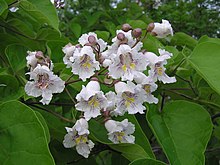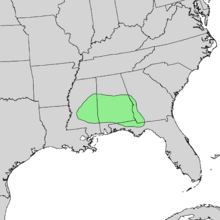Southern Catalpa
| Southern catalpa | |
|---|---|
 |
|
| Scientific classification | |
| Kingdom: | Plantae |
| (unranked): | Angiosperms |
| (unranked): | Eudicots |
| (unranked): | Asterids |
| Order: | Lamiales |
| Family: | Bignoniaceae |
| Genus: | Catalpa |
| Species: | C. bignonioides |
| Binomial name | |
|
Catalpa bignonioides Walter |
|
 |
|
| Natural range of Catalpa bignonioides | |
Catalpa bignonioides is a species of Catalpa that is native to the southeastern United States in Alabama, Florida, Georgia, Louisiana, and Mississippi. Common names include southern catalpa, cigartree, and Indian-bean-tree.
It is a medium-sized deciduous tree growing to 15–18 metres (49–59 ft) tall, with a trunk up to 1 metre (3 ft 3 in) diameter, with brown to gray bark, maturing into hard plates or ridges. The short thick trunk supports long and straggling branches which form a broad and irregular head. The roots are fibrous and branches are brittle. Its juices are watery and bitter.
The leaves are large and heart shaped, being 20–30 cm long and 15–20 cm broad. The bright green leaves appear late and as they are full grown before the flower clusters open, add much to the beauty of the blossoming tree. They secrete nectar, a most unusual characteristic for leaves, by means of groups of tiny glands in the axils of the primary veins.
The flowers are 2.5–4 cm across, trumpet shaped, white with yellow spots inside; they grow in panicles of 20-40. In the northern states of the USA, it is a late bloomer, putting forth great panicles of white flowers in June or early in July when the flowers of other trees have mostly faded. These cover the tree so thickly as almost to conceal the full grown leaves. The general effect of the flower cluster is a pure white, but the individual corolla is spotted with purple and gold, and some of these spots are arranged in lines along a ridge, so as to lead directly to the honey sweets within. A single flower when fully expanded is two inches long and an inch and a half wide. It is two-lipped and the lips are lobed, two lobes above and three below, as is not uncommon with such corollas. The flower is perfect, possessing both stamens and pistils; nevertheless, the law of elimination is at work and of the five stamens that we should expect to find, three have aborted, ceased to bear anthers and have become filaments simply. Then, too, the flowers refuse to be self-fertilized. Each flower has its own stamens and its own stigma but the lobes of the stigma remain closed until after the anthers have opened and discharged their pollen; after they have withered and become effete then the stigma opens and invites the wandering bee. The entire Pink family behave in this way.
The fruit is a long, thin bean like pod 20–40 cm long and 8–10 mm diameter; it often stays attached to tree during winter. The pod contains numerous flat light brown seeds with two papery wings.
...
Wikipedia
